
Catfish are a diverse group of ray-finned fish. Named for their prominent barbels, which resemble a cat's whiskers, catfish range in size and behavior from the three largest species alive, the Mekong giant catfish from Southeast Asia, the wels catfish of Eurasia, and the piraíba of South America, to detritivores, and even to a tiny parasitic species commonly called the candiru, Vandellia cirrhosa. Neither the armour-plated types nor the naked types have scales. Despite their name, not all catfish have prominent barbels or "whiskers". Members of the Siluriformes order are defined by features of the skull and swimbladder. Catfish are of considerable commercial importance; many of the larger species are farmed or fished for food. Many of the smaller species, particularly the genus Corydoras, are important in the aquarium hobby. Many catfish are nocturnal, but others are crepuscular or diurnal.

The flathead catfish, also called by several common names including mudcat or shovelhead cat, is a large species of North American freshwater catfish in the family Ictaluridae. It is the only species of the genus Pylodictis. Ranging from the lower Great Lakes region to northern Mexico, it has been widely introduced and is an invasive species in some areas. The closest living relative of the flathead catfish is the much smaller widemouth blindcat, Satan eurystomus.
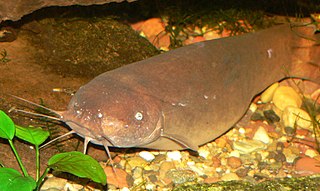
Malapterurus electricus is a thickset fish with six mouth barbels and a single fin on its back, just anterior to the rounded tail fin. It is brownish or grayish, irregularly spotted with black, and attains a length and weight of about 1.2 metres and 23 kilograms (51 lb) M. electricus is capable of generating and controlling the discharge of up to 450 volts of electricity. It uses its power to defend itself and to capture prey.

The Doradidae are a family of catfishes also known as thorny catfishes, raphael catfishes or talking catfishes. These fish are native to South America, primarily the Amazon basin and the Guianas.
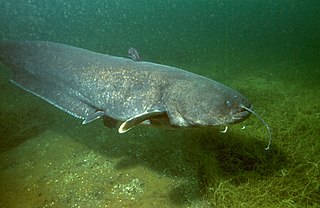
The wels catfish, also called sheatfish or just wels, is a large species of catfish native to wide areas of central, southern, and eastern Europe, in the basins of the Baltic, Black and Caspian Seas. It has been introduced to Western Europe as a prized sport fish and is now found from the United Kingdom east to Kazakhstan and China and south to Greece and Turkey.

Lithodoras dorsalis, the rock-bacu, is the only species in the genus Lithodoras of the catfish family Doradidae. This species originates from the Amazon basin in Brazil and estuaries near Cayenne, French Guiana. These fish feed on the leaves of macrophytes. When the forests are flooded, they feed exclusively on fruits and seeds, acting as an agent of seed dispersal. Reproduction occurs once a year and juveniles are often seen in large numbers in the estuary of the Amazon. These fish reach a length of 100 centimetres (39 in) TL and a weight of up to 15 kilograms (33 lb).
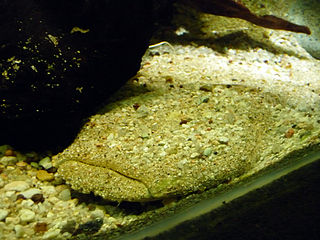
Lophiosilurus alexandri is a species of catfish of the family Pseudopimelodidae, and the only species of the monotypic genus Lophiosilurus.
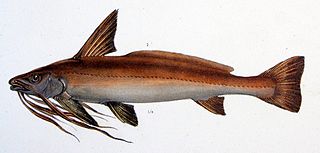
Pinirampus pirinampu is a species of catfish of the family Pimelodidae. P. pirinampu is also known as the flatwhiskered catfish.

The giant talking catfish or giant raphael catfish is a species of thorny catfish that is native to the Amazon Basin in Bolivia, Brazil, Colombia, Ecuador and Peru. This species grows to a length of 60 centimetres (24 in) SL and a maximum weight of 4.6 kilograms (10 lb). These fish are harvested in local commercial fisheries.
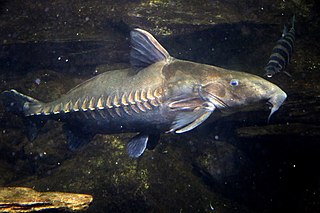
Oxydoras niger, the ripsaw catfish or cuiu cuiu, is a species of thorny catfish native to the Amazon, Essequibo and São Francisco basins in Bolivia, Brazil, Colombia, Ecuador, Guyana, Peru and Venezuela. This species grows to a length of 100 centimetres (39 in) SL and weights up to 13 kilograms (29 lb). This species is a minor component of local commercial fisheries. It has lateral thorns that can damage any potential predator or handler. It feeds by shifting through sand and detecting eatable parts with the taste receptors in the roof and floor of its mouth.

Leiarius is a genus of long-whiskered catfishes native to South America. Most of the genus' species are found in the aquarium hobby as ornamental fish.

The bayad, is a species of bagrid catfish from Africa.
Oxydoras kneri is a species of thorny catfish found in the Paraná River basin in Argentina, Bolivia, Brazil, Paraguay and Uruguay. This species grows to a length of 70.0 centimetres (27.6 in) TL and reaches a weight of 9.0 kilograms (19.8 lb). This species is caught commercially for human consumption. O. kneri is omnivorous, feeding mainly on insects, crustaceans, mollusks, other invertebrates and some vegetable material.
Carlarius heudelotii, the smoothmouth sea catfish, is a species of sea catfish.

Rudolf Ignaz Kner was an Austrian geologist, paleontologist, zoologist and ichthyologist. He also wrote some poems which were published by his brother-in-law K.A. Kaltenbrunner.
The hard-palate catfish, also known as the hard-plate catfish, is a species of sea catfish in the family Ariidae. It was described by Albert William Herre in 1935, originally under the genus Arius. It is a tropical freshwater fish which is found in Indonesia and Papua New Guinea. It reaches a maximum standard length of 60 cm (24 in), with both sexes more commonly reaching an SL of 35 cm (14 in). It reaches a maximum weight of 1.8 kg (4.0 lb).
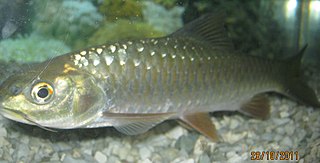
Neolissochilus hexagonolepis is a species of cyprinid in the genus Neolissochilus. It inhabits India, Bangladesh, Nepal, Myanmar, Thailand, Malaysia, Indonesia, China, Bhutan, Pakistan and Vietnam. It has a maximum length of 120.0 centimetres (3.937 ft) and a maximum published weight of 11.0 kilograms (24.3 lb).

The blacktip sea catfish, also known as the Dussumier's catfish, the giant marine cat fish, the Shupanga sea catfish, or the tropical seacatfish, is a species of catfish in the family Ariidae. It was described by Achille Valenciennes in 1840, originally under the genus Arius. It inhabits rivers and marine waters ranging between Africa and India in the Indo-western Pacific. It dwells at a depth range of 20 to 50 m. It reaches a maximum standard length of 62 cm (24 in), and a maximum weight of 1.4 kg (3.1 lb).
The Couma sea catfish, also known as the Pemecou sea catfish, is a species of catfish in the family Ariidae. It was described by Achille Valenciennes in 1840, originally under the genus Bagrus. It inhabits estuaries and rivers in Guyana, French Guiana, Suriname, Brazil, Trinidad and Tobago, and Venezuela. It reaches a maximum total length of 97 cm (38 in), more commonly reaching a TL of 50 cm (20 in). It reaches a maximum weight of 30 kg (66 lb). Its maximum known life expectancy is 5 years.















